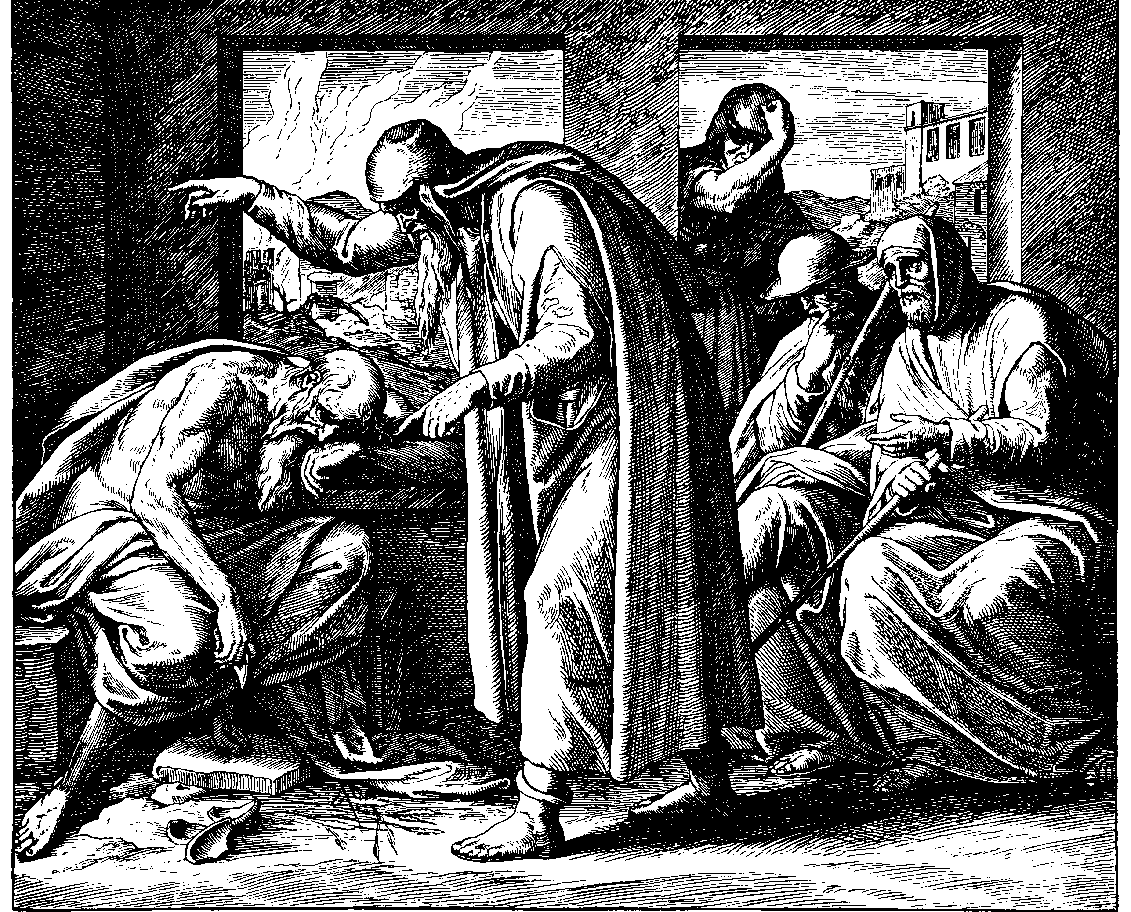Parent’s Guide to Bible History
By Mary Abrahamson
A Parents’ Guide to beginning Catechesis
or put more simply,
How do I teach my small child about God?
Part III Bible History
Why do we teach our children Bible History? Why do we get them Bible Story books with nice illustrations? Why do we buy those picture books portraying the more well-known stories from the Bible?
Good questions. And for the basic, “Why?” many would not have a ready answer. Others might have a wrong answer. I’ve observed two primary notions or focus in the teaching and presenting of Bible History among Christians today that are wrong. Yes, there are wrong reasons to teach Bible history. God can and does still work through such teach, even if the focus is wrong. But we must be careful to pass on to our children a Biblical goal.
Some teach Bible stories to increase morality. And this is a vast misunderstanding of Sanctification and a misapplication of Gods Law. To teach Bible history as though the primary purpose is to make us better people is simply wrong.
We know from the rest of Scripture that that we are and always will be, until this world ends, sinners. We don’t get better by wanting, or by trying hard, or by reading over and over again how “good” God wants His people to be. For some, such moral teaching leads to despair because of their own failings. For others, the focus on works leads to the lie that their own Biblical life choices somehow make them better or more deserving individuals.
The second common misuse of the Bible in teaching children is to use it primarily for the emotional appeal. Some stories are sweet, others show some gratifying success, and still more portray an act of great love or courage. Some also show some great evil. This use is akin to holding up any secular story as noble or exciting or enriching; or on the other hand, as a warning.
Yes, the accounts of what we might call the Bible heroes can be exciting or sad or inspiring or frightening. I don’t deny that. But if that is the primary use of the Bible in our children’s lives, we are robbing them of the fullness of the Gospel message. The Bible offers so much more than a collection of stories with emotional appeal.
What, then, is the purpose of the reading Bible stories to our children? Why should we want them to learn Bible History?
Most importantly, we want our children to know their Lord and Savior. Reading Bible stories to our children is a Means of Grace. God’s Word teaches that the Gospel, in Word and Sacrament, gives faith and thereby gives us forgiveness of sins and Salvation through Jesus’ blood and merit. When our children hear God’s Word, or read it for themselves, the Holy Spirit works these blessings in their hearts and lives.
Another important and appropriate focus of using Bible history is to teach. We want to give our children the whole of God’s work for us. Whereas the former reason focused on God’s work in us, this second one is more about teaching the specifics and depth of what God has done for us.
From the beginning of time we can see God’s work for the earthly care of His people. But from almost as early, from the time of the very first sin, and on throughout the Old and New Testaments, we see over and over again humanity’s need for a Savior and how God promised to send One.
We see the cycle repeated: the people sin, God sends trials and tribulation to remind them to turn to Him, the people repent, and God forgives. Through all this, again and again, is the continual message of the coming Savior, who will break for all eternity that cycle, and make us right with God. The accounts of God’s people, His servants, are filled with images and foreshadowings that when put together create a very detailed and cohesive representation of the Savior and His Work for us and our Salvation.
When reading through Bible stories with your children, notice what your focus is. Make a point of talking about sin and our Savior when reading the accounts. Point out the promises of God. Bring in, or tie together, as much as you’re able, how God fulfilled or will fulfill His promises. Some promises are more immediately fulfilled through God’s work in His people at a specific time in history. Others are fulfilled later, in New Testament times. Some will be fulfilled at the last day. And still others even after they are fulfilled, still point to or foreshadow some aspect of Jesus’ coming and our Salvation. Notice the pictures and images of the Savior who is to come: what He will be like, what He will do, how He will save us.
What do we use to teach and how do we do it?
The Bible.
Read it to your children.
Don’t be afraid to use the Bible. Your child will hear the stories of our God straight from Him. God’s Word is powerful; it works faith in even the youngest listener.
If you have a beginning reader, encourage him or her to read the Bible to you. Your child will get practice in reading the Biblical writing style, which is so daunting for those of us who may have rarely or even never used the Bible ourselves. Have your children take a turn reading a selection for family devotions. This will give them the practice and a model they can use one day in their own home.
The Gospels contain some of the easiest vocabulary and language, so they are a good starting point for beginners. Or choose an account they know well. In that way, a child can practice his or her Biblical reading without having to grasp some unfamiliar story line.
It can be hard, however, for young children to follow the story and grasp the images when reading from the Bible. Many of us augment Bible training with Bible story books. Many are nicely illustrated to help the children remember the story.
But please keep in mind this warning. There is much creative retelling of Bible stories in many of these books.
There are places where a small word from the biblical account is changed to slant or shade a meaning. A good example of that is when Jesus institutes the Lord’s Supper. In many Bible story books, Jesus says, “This symbolizes my body,” rather than, “This is my body.”
Sometimes an author will choose to include, over and above what’s in the Biblical text, the thoughts or motives of a Biblical person. This can make the story flow better, or the retelling more interesting. But we must remember that anything that is not in the Bible is fiction. This is not to be held to as Biblical truth.
You will also find folklore that is not Biblical. This often consists of small details that are assumed to be Biblical, because they have been told and retold so many times that they have become “truth.” Examples of this are Noah closing the door of the ark rather than God; or three wisemen visiting Jesus. These are so prevalent many of us don’t even realize how many of these we believe, until we begin to read the accounts directly from the Bible.
These “micro-changes” may seem like small things. In folklore or even folk music, we see variations from generation to generation, and community to community. Using this comparison, we can easily see how easy it would be for even small details to change God’s Word from throughout time. The story God gives us in His Holy Word, the realities of Sin and Grace, Life and Death, Heaven and Hell, these are realities we don’t want to change.
If you are looking to buy a Bible story book or Bible history for your child, buy from a trusted publisher. Your pastor can help you find a good source or even recommend a book or two.
If you already have Bible stories books, and you notice they contain some errors, don’t feel like you have to go out buy all new. If you want to, and if your budget allows, wonderful! Buy a new one. One can never have too many ways to engage a child in God’s Word.
But don’t despair about reading from the one you have. How God’s Word is regularly treated and portrayed from your mouth as parent, will stick with a child longer than something from a book.
Take using these books as a challenge.
Read the Biblical account yourself, so that you know the true version. You will be prepared to point out any differences. This, too, is a skill your child will need. There will always be someone writing something that opposes God’s Word. You will teach by your example to examine what you read or hear, and hold it up to God’s Word for comparison. You can say, “Oh, that’s silly! That’s not what God tells us,” or something like that. Then tell your children the true Biblical account.
Bible Stories, Bible History, Biblical Accounts (a few notes on terminology)
What do each of those labels mean, and what do the different words imply?
Bible story: Each individual account of a character from the Bible. For example, there is the story of creation, the story of the flood, and the multitude of stories about Abraham. This is probably the most common term used for such individual accounts.
Bible history: Tying together the individual Bible stories to create a entire timeline of events.
The important things to keep in mind with both of these terms is that the stories or accounts are not isolated. The history is not simply a list of events. God used history. He designed history. God used individual events and people to teach them about their sin and their need for a Savior. He used individual events and people to point to that Savior to teach about Him. If we treat the individual accounts as isolated events, they easily become nothing more than moral lessons or emotionally appealing stories. It’s important to remember to use the stories and history of the Bible to teach about Jesus.
Biblical account: This term has become popular because of, or as a reaction against, the widespread perception of the Bible as a mere mythology. In academic and theological circles, especially since the midpoint of the 20th century, the great majority of college graduates have been taught that the Bible is no different than the Greek myths or Aesop’s fables or Grimm’s fairy tales. During the past several decades many pastors, teachers, and parents have gradually come to believe this about the Bible. The word, account, lends a more historical implication to the term, and so some prefer it to the word, story.
This is a valid preference. But just as we often refer to other historical events as stories, it’s also reasonable to call the Biblical accounts stories. We might for instance say, “Do you remember the story of Abe Lincoln and how he had to walk miles and miles just to borrow a book to read.” Or we might refer to the story of Julius Ceasar’s assassination or Marie Antoinette fleeing Paris. I even had a child’s American history named something like, Tales of America.
In the same way, we can in good conscience use the word story to refer to the things Biblical people did and experienced.
Please be aware, though, that many, even in our churches sadly enough, do not believe in the Bible as anything more than folklore. When you talk about God and His Word with others, remember that they may be using the word story to imply a fiction, whereas you use it knowing it is God’s True History.
As you teach your children God’s True History, you can also, throughout the years, explain to them them these differing views, so that they understand the different usages of the word, Bible Story.




One Comment
Rev. Dean Christ
Very good.